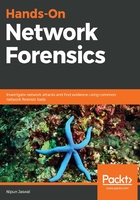
上QQ阅读APP看书,第一时间看更新
Network forensics investigation methodology
To assure accurate and meaningful results at the end of a network forensic exercise, you, as a forensic investigator, must follow a rigid path through a methodological framework. This path is shown in the following diagram:

Obtain, Strategize, Collect, Analyze, and Report (OSCAR) is one such framework that ensures appropriate and constant results. Let's look at each phase from a network forensics point of view:
- Obtain information: Obtaining information about the incident and the environment is one of the first things to do in a network forensics exercise. The goal of this phase is to familiarize a forensic investigator with the type of incident. The timestamps and timeline of the event, the people, systems, and endpoints involved in the incident—all of these facts are crucial in building up a detailed picture of the event.
- Strategize: Planning the investigation is one of the critical phases in a network forensics scenario, since logs from various devices can differ in their nature; for example, the volatility of log entries from a firewall compared with that of details such as the ARP of a system would be very different. A good strategy would impact the overall outcome of the investigation. Therefore, you should keep the following points in mind while strategizing the entire forensics investigation process:
- Define clear goals and timelines
- Find the sources of evidence
- Analyze the cost and value of the sources
- Prioritize acquisition
- Plan timely updates for the client
- Collect: In the previous phase, we saw how we need to strategize and plan the acquisition of evidence. In the collect phase, we will go ahead and acquire the evidence as per the plan; however, collecting the evidence itself requires you to document all the systems that are accessed and used, capturing and saving the data streams to the hard drive and collecting logs from servers and firewalls. Best practices for evidence collection include the following:
- Make copies of the evidence and generate cryptographic hashes for verifiability
- Never work on the original evidence; use copies of the data instead
- Use industry-standard tools
- Document all your actions
- Analyze: The analysis phase is the core phase where you start working on the data and try your hands at the riddle. In this phase, you will make use of multiple automated and manual techniques using a variety of tools to correlate data from various sources, establishing a timeline of events, eliminating false positives, and creating working theories to support evidence. We will spend most of the time in this book discussing the analysis of data.
- Report: The report that you produce must be in layman's terms—that is, it should be understood by non-techie people, such as legal teams, lawyers, juries, insurance teams, and so on. The report should contain executive summaries backed by the technical evidence. This phase is considered one of the essential stages, since the last four steps need to be explained in this one.
For more on OSCAR methodology, you can visit https://www.researchgate.net/figure/OSCAR-methodology_fig2_325465892.